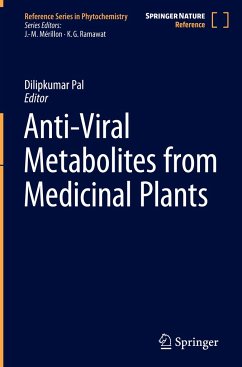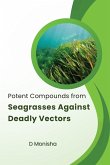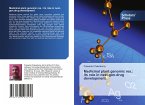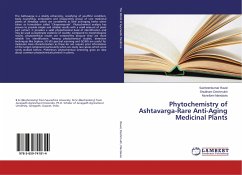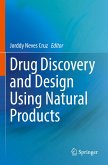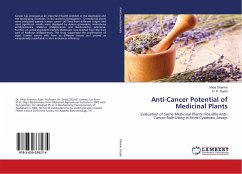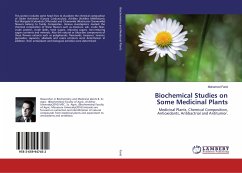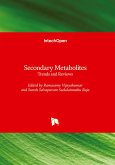Anti-Viral Metabolites from Medicinal Plants
Herausgeber: Pal, Dilipkumar
Anti-Viral Metabolites from Medicinal Plants
Herausgeber: Pal, Dilipkumar
- Gebundenes Buch
- Merkliste
- Auf die Merkliste
- Bewerten Bewerten
- Teilen
- Produkt teilen
- Produkterinnerung
- Produkterinnerung
This reference work covers general concepts of anti-viral metabolites, classifications, ethnopharmacology, chemistry, clinical and preclinical studies focusing on different medicinal plants against various types of viral infections. Various plants have been used in medicine since ancient times and are known for their strong therapeutic effects. The book will describe potential antiviral properties of medicinal plants against a diverse group of viruses, and provide an insight to the potential plants possess for broad-spectrum antiviral effects against emerging viral infections. The book aims to…mehr
Andere Kunden interessierten sich auch für
![Potent Compounds from Seagrasses Against Deadly Vectors Potent Compounds from Seagrasses Against Deadly Vectors]() Monisha DPotent Compounds from Seagrasses Against Deadly Vectors24,99 €
Monisha DPotent Compounds from Seagrasses Against Deadly Vectors24,99 €![Medicinal plant genomic res.: its role in next-gen.drug development Medicinal plant genomic res.: its role in next-gen.drug development]() Prasanta ChakrabortyMedicinal plant genomic res.: its role in next-gen.drug development39,99 €
Prasanta ChakrabortyMedicinal plant genomic res.: its role in next-gen.drug development39,99 €![Phytochemistry of Ashtavarga-Rare Anti-Aging Medicinal Plants Phytochemistry of Ashtavarga-Rare Anti-Aging Medicinal Plants]() Sacheenkumar RavalPhytochemistry of Ashtavarga-Rare Anti-Aging Medicinal Plants36,99 €
Sacheenkumar RavalPhytochemistry of Ashtavarga-Rare Anti-Aging Medicinal Plants36,99 €![Drug Discovery and Design Using Natural Products Drug Discovery and Design Using Natural Products]() Drug Discovery and Design Using Natural Products164,99 €
Drug Discovery and Design Using Natural Products164,99 €![Anti-Cancer Potential of Medicinal Plants Anti-Cancer Potential of Medicinal Plants]() Vikas SharmaAnti-Cancer Potential of Medicinal Plants40,99 €
Vikas SharmaAnti-Cancer Potential of Medicinal Plants40,99 €![Biochemical Studies on Some Medicinal Plants Biochemical Studies on Some Medicinal Plants]() Mohamed FaridBiochemical Studies on Some Medicinal Plants42,99 €
Mohamed FaridBiochemical Studies on Some Medicinal Plants42,99 €![Secondary Metabolites Secondary Metabolites]() Secondary Metabolites155,00 €
Secondary Metabolites155,00 €-
-
-
This reference work covers general concepts of anti-viral metabolites, classifications, ethnopharmacology, chemistry, clinical and preclinical studies focusing on different medicinal plants against various types of viral infections. Various plants have been used in medicine since ancient times and are known for their strong therapeutic effects. The book will describe potential antiviral properties of medicinal plants against a diverse group of viruses, and provide an insight to the potential plants possess for broad-spectrum antiviral effects against emerging viral infections. The book aims to target a broad audience including virologists, molecular biologist, microbiologist and scientists working with natural products as well as researchers, students, healthcare experts involved in pharmaceutical and medical field.
Hinweis: Dieser Artikel kann nur an eine deutsche Lieferadresse ausgeliefert werden.
Hinweis: Dieser Artikel kann nur an eine deutsche Lieferadresse ausgeliefert werden.
Produktdetails
- Produktdetails
- Verlag: Springer International Publishing / Springer Nature Switzerland
- 1st edition 2024
- Seitenzahl: 1152
- Erscheinungstermin: 1. November 2023
- Englisch
- Abmessung: 241mm x 160mm x 50mm
- Gewicht: 2072g
- ISBN-13: 9783031121982
- ISBN-10: 3031121988
- Artikelnr.: 64614665
- Herstellerkennzeichnung Die Herstellerinformationen sind derzeit nicht verfügbar.
- Verlag: Springer International Publishing / Springer Nature Switzerland
- 1st edition 2024
- Seitenzahl: 1152
- Erscheinungstermin: 1. November 2023
- Englisch
- Abmessung: 241mm x 160mm x 50mm
- Gewicht: 2072g
- ISBN-13: 9783031121982
- ISBN-10: 3031121988
- Artikelnr.: 64614665
- Herstellerkennzeichnung Die Herstellerinformationen sind derzeit nicht verfügbar.
Dr. Dilipkumar Pal (M. Pharm, Ph.D, F.I.C., Chartered Chemist, Post Doct. in Australia) is now working in the post of Associate Professor, Department of Pharmaceutical Sciences, Guru Ghasidash Vishwavidyalaya (A Central University), Bilaspur, C.G., 495 009, India. He received his master and PhD degree from Jadavpur University, Kolkata and performed post doctoral research as an "Endeavour research fellow" at the University of Sydney, Australia. His areas of research interest include "Phytochemical and pharmacological evaluation of indigenous plants" and 'Natural Biopolymers'. He has published 177 full research papers in peer-reviewed national and international scientific journals and contributed 117 abstracts in different national and international conferences, mostly related to his specialisation. He has written 2 books and 65 book chapters and edited 08 books published by reputed international publishers. His research publications have acquired a highly remarkable cited recordin Scopus and Google Scholar (H-Index: 44; i-10-index 103, citation 6312 till date). During Dr. Pal's 21 year research-oriented teaching profession he has received 13 prestigious national and international professional awards. He has guided 8 Ph. D and 40 master students for their dissertation thesis. He is the reviewer and Editorial Board member of 27 and 29 scientific journals, respectively. Dr Pal has been working as the Editor-in-Chief of one research journal also. He is the member and life member of many professional organizations. Recently, Dr Pal has been included in World's top 2 % Indian Scientist (Pharmacy and Pharmacology) (as released by Stanford University, USA).
Chapter 1 Introduction of medicinal plants as source of anti-viral
metabolite(s), effects on health and general adverse effects.- Chapter
2:General plants showing anti-viral activity giving emphasis on CDRI's
biological screening programme.- Chapter 3: Classification of medicinal
plants having anti-viral activity as per (i) family and (ii) types of viral
infections.- Chapter 4: Ethnopharmacology, Chemistry, Clinical and
preclinical studies focusing on use of different medicinal plants against
Herpes simplex virus (HSV) Type 1 infections.- Chapter
5: Ethnopharmacology, Chemistry, Clinical and preclinical studies focusing
on use of different medicinal plants against Herpes simplex virus (HSV)
Type 2 infections.- Chapter 6: Role of various medicinal plants against in
HIV infection in human with possible mechanism of action and functions of
secondary metabolites.- Chapter 7: Ethnopharmacology, chemistry, clinical
and preclinical studies focusing on use of different medicinal plants
against Hepatitis B infections.- Chapter 8: Antiviral effects of different
medicinal plants against Hepatitis C (HCV) infection: Role of
phytochemicals.- Chapter 9: Medicinal plants in controlling Pox virus
affections:Ethnopharmacology, chemistry, clinical, preclinical studies and
future perspectives.- Chapter 10: Role of medicinal plants in prevention
and treatment of Respiratory viral infections.- Chapter 11: Assessment of
effectiveness of herbal drugs in prevention and treatment against
Gastrointestinal viral diseases.- Chapter 12: Antiviral potential of
medicinal plants in treatment of diseases caused by Influenza virus A: Role
of secondary metabolites, clinical and preclinical studies and future
perspectives.- Chapter 13: Role of medicinal plants in treatment of
diseases caused by Influenza virus B and Parainfluenza virus type 3.-
Chapter 14: Ethnopharmacology, chemistry, clinical and preclinical studies
focusing on the uses of herbal drugs against Polio Infections.- Chapter
15: Ethnopharmacology, chemistry, clinical and preclinical studies focusing
on use of medicinal plants against SARS-CoV/Corona virus infections.-
Chapter 16: Medicinal plants in controlling and treatment of diseases
caused by Viral Haemorrhagic Septicaemia Virus (VHSV).- Chapter
17:Ethnopharmacology, chemistry, Clinical and preclinical studies focusing
on use of different medicinal plants against vesicular stomatitis virus
(VSV) infections.- Chapter 18: Ethnopharmacology, chemistry, clinical and
preclinical studies focusing on use of various medicinal plants against
Human Adenovirus Type 1 infections.- Chapter 19: Medicinal plants used by
traditional medical practitioner in controlling and treatment of Cutaneous
viral diseases: Ethnopharmacology, chemistry, Clinical and preclinical
studies.- Chapter 20: Herbal drugs and medicinal plants in controlling and
treatment for the diseases caused by Dengue virus (DEN-1 & 2):
Ethnopharmacology, chemistry, clinical and preclinical studies.- Chapter
21: Ethnopharmacology, chemistry, Clinical and preclinical studies focusing
on use of natural medicinal plants against Neurological viral diseases.-
Chapter 22: Ethnopharmacology, chemistry, clinical and preclinical studies
focusing on traditional crude drugs against Encephalitis infection.-
Chapter 23: Ethnopharmacology, chemistry, Clinical and preclinical studies
focusing on use natural plants in the treatment of Renal syndrome caused by
viruses.- Chapter 24: Natural products in controlling and treatment of
cancers and genital warts caused by different viruses.- Chapter 25: Role of
traditional plants in controlling and treatment of fever, joint pain and
pogosta diseases caused by viruses.- Chapter 26: Natural medicinal plants
used in in controlling and treatment of diseases caused by Coxsackie and
Coxsackie virus B3 with possible mechanism of action and role of
phytochemicals.-Chapter 27: Phytochemical, clinical and preclinical studies
focusing on use Indigenous plants against Cytomegalovirus, Cytomegalovirus
B1 and Epstein-Barr virus infection: Prevalence and impact on patients with
haematological diseases.- Chapter 28: Flavonoids: promising natural
compounds against viral infections: Ethnopharmacology, chemistry, mechanism
of action, clinical, preclinical studies and future perspectives.- Chapter
29: Coumarins: emerging antiviral compounds from natural origin:
Ethnopharmacology, chemistry, mechanism of action, clinical, preclinical
studies and future perspectives.- Chapter 30: Antiviral potential of
Curcumins: Ethnopharmacology, chemistry, clinical studies focusing on
mechanism of action and future perspectives.
metabolite(s), effects on health and general adverse effects.- Chapter
2:General plants showing anti-viral activity giving emphasis on CDRI's
biological screening programme.- Chapter 3: Classification of medicinal
plants having anti-viral activity as per (i) family and (ii) types of viral
infections.- Chapter 4: Ethnopharmacology, Chemistry, Clinical and
preclinical studies focusing on use of different medicinal plants against
Herpes simplex virus (HSV) Type 1 infections.- Chapter
5: Ethnopharmacology, Chemistry, Clinical and preclinical studies focusing
on use of different medicinal plants against Herpes simplex virus (HSV)
Type 2 infections.- Chapter 6: Role of various medicinal plants against in
HIV infection in human with possible mechanism of action and functions of
secondary metabolites.- Chapter 7: Ethnopharmacology, chemistry, clinical
and preclinical studies focusing on use of different medicinal plants
against Hepatitis B infections.- Chapter 8: Antiviral effects of different
medicinal plants against Hepatitis C (HCV) infection: Role of
phytochemicals.- Chapter 9: Medicinal plants in controlling Pox virus
affections:Ethnopharmacology, chemistry, clinical, preclinical studies and
future perspectives.- Chapter 10: Role of medicinal plants in prevention
and treatment of Respiratory viral infections.- Chapter 11: Assessment of
effectiveness of herbal drugs in prevention and treatment against
Gastrointestinal viral diseases.- Chapter 12: Antiviral potential of
medicinal plants in treatment of diseases caused by Influenza virus A: Role
of secondary metabolites, clinical and preclinical studies and future
perspectives.- Chapter 13: Role of medicinal plants in treatment of
diseases caused by Influenza virus B and Parainfluenza virus type 3.-
Chapter 14: Ethnopharmacology, chemistry, clinical and preclinical studies
focusing on the uses of herbal drugs against Polio Infections.- Chapter
15: Ethnopharmacology, chemistry, clinical and preclinical studies focusing
on use of medicinal plants against SARS-CoV/Corona virus infections.-
Chapter 16: Medicinal plants in controlling and treatment of diseases
caused by Viral Haemorrhagic Septicaemia Virus (VHSV).- Chapter
17:Ethnopharmacology, chemistry, Clinical and preclinical studies focusing
on use of different medicinal plants against vesicular stomatitis virus
(VSV) infections.- Chapter 18: Ethnopharmacology, chemistry, clinical and
preclinical studies focusing on use of various medicinal plants against
Human Adenovirus Type 1 infections.- Chapter 19: Medicinal plants used by
traditional medical practitioner in controlling and treatment of Cutaneous
viral diseases: Ethnopharmacology, chemistry, Clinical and preclinical
studies.- Chapter 20: Herbal drugs and medicinal plants in controlling and
treatment for the diseases caused by Dengue virus (DEN-1 & 2):
Ethnopharmacology, chemistry, clinical and preclinical studies.- Chapter
21: Ethnopharmacology, chemistry, Clinical and preclinical studies focusing
on use of natural medicinal plants against Neurological viral diseases.-
Chapter 22: Ethnopharmacology, chemistry, clinical and preclinical studies
focusing on traditional crude drugs against Encephalitis infection.-
Chapter 23: Ethnopharmacology, chemistry, Clinical and preclinical studies
focusing on use natural plants in the treatment of Renal syndrome caused by
viruses.- Chapter 24: Natural products in controlling and treatment of
cancers and genital warts caused by different viruses.- Chapter 25: Role of
traditional plants in controlling and treatment of fever, joint pain and
pogosta diseases caused by viruses.- Chapter 26: Natural medicinal plants
used in in controlling and treatment of diseases caused by Coxsackie and
Coxsackie virus B3 with possible mechanism of action and role of
phytochemicals.-Chapter 27: Phytochemical, clinical and preclinical studies
focusing on use Indigenous plants against Cytomegalovirus, Cytomegalovirus
B1 and Epstein-Barr virus infection: Prevalence and impact on patients with
haematological diseases.- Chapter 28: Flavonoids: promising natural
compounds against viral infections: Ethnopharmacology, chemistry, mechanism
of action, clinical, preclinical studies and future perspectives.- Chapter
29: Coumarins: emerging antiviral compounds from natural origin:
Ethnopharmacology, chemistry, mechanism of action, clinical, preclinical
studies and future perspectives.- Chapter 30: Antiviral potential of
Curcumins: Ethnopharmacology, chemistry, clinical studies focusing on
mechanism of action and future perspectives.
Chapter 1 Introduction of medicinal plants as source of anti-viral
metabolite(s), effects on health and general adverse effects.- Chapter
2:General plants showing anti-viral activity giving emphasis on CDRI's
biological screening programme.- Chapter 3: Classification of medicinal
plants having anti-viral activity as per (i) family and (ii) types of viral
infections.- Chapter 4: Ethnopharmacology, Chemistry, Clinical and
preclinical studies focusing on use of different medicinal plants against
Herpes simplex virus (HSV) Type 1 infections.- Chapter
5: Ethnopharmacology, Chemistry, Clinical and preclinical studies focusing
on use of different medicinal plants against Herpes simplex virus (HSV)
Type 2 infections.- Chapter 6: Role of various medicinal plants against in
HIV infection in human with possible mechanism of action and functions of
secondary metabolites.- Chapter 7: Ethnopharmacology, chemistry, clinical
and preclinical studies focusing on use of different medicinal plants
against Hepatitis B infections.- Chapter 8: Antiviral effects of different
medicinal plants against Hepatitis C (HCV) infection: Role of
phytochemicals.- Chapter 9: Medicinal plants in controlling Pox virus
affections:Ethnopharmacology, chemistry, clinical, preclinical studies and
future perspectives.- Chapter 10: Role of medicinal plants in prevention
and treatment of Respiratory viral infections.- Chapter 11: Assessment of
effectiveness of herbal drugs in prevention and treatment against
Gastrointestinal viral diseases.- Chapter 12: Antiviral potential of
medicinal plants in treatment of diseases caused by Influenza virus A: Role
of secondary metabolites, clinical and preclinical studies and future
perspectives.- Chapter 13: Role of medicinal plants in treatment of
diseases caused by Influenza virus B and Parainfluenza virus type 3.-
Chapter 14: Ethnopharmacology, chemistry, clinical and preclinical studies
focusing on the uses of herbal drugs against Polio Infections.- Chapter
15: Ethnopharmacology, chemistry, clinical and preclinical studies focusing
on use of medicinal plants against SARS-CoV/Corona virus infections.-
Chapter 16: Medicinal plants in controlling and treatment of diseases
caused by Viral Haemorrhagic Septicaemia Virus (VHSV).- Chapter
17:Ethnopharmacology, chemistry, Clinical and preclinical studies focusing
on use of different medicinal plants against vesicular stomatitis virus
(VSV) infections.- Chapter 18: Ethnopharmacology, chemistry, clinical and
preclinical studies focusing on use of various medicinal plants against
Human Adenovirus Type 1 infections.- Chapter 19: Medicinal plants used by
traditional medical practitioner in controlling and treatment of Cutaneous
viral diseases: Ethnopharmacology, chemistry, Clinical and preclinical
studies.- Chapter 20: Herbal drugs and medicinal plants in controlling and
treatment for the diseases caused by Dengue virus (DEN-1 & 2):
Ethnopharmacology, chemistry, clinical and preclinical studies.- Chapter
21: Ethnopharmacology, chemistry, Clinical and preclinical studies focusing
on use of natural medicinal plants against Neurological viral diseases.-
Chapter 22: Ethnopharmacology, chemistry, clinical and preclinical studies
focusing on traditional crude drugs against Encephalitis infection.-
Chapter 23: Ethnopharmacology, chemistry, Clinical and preclinical studies
focusing on use natural plants in the treatment of Renal syndrome caused by
viruses.- Chapter 24: Natural products in controlling and treatment of
cancers and genital warts caused by different viruses.- Chapter 25: Role of
traditional plants in controlling and treatment of fever, joint pain and
pogosta diseases caused by viruses.- Chapter 26: Natural medicinal plants
used in in controlling and treatment of diseases caused by Coxsackie and
Coxsackie virus B3 with possible mechanism of action and role of
phytochemicals.-Chapter 27: Phytochemical, clinical and preclinical studies
focusing on use Indigenous plants against Cytomegalovirus, Cytomegalovirus
B1 and Epstein-Barr virus infection: Prevalence and impact on patients with
haematological diseases.- Chapter 28: Flavonoids: promising natural
compounds against viral infections: Ethnopharmacology, chemistry, mechanism
of action, clinical, preclinical studies and future perspectives.- Chapter
29: Coumarins: emerging antiviral compounds from natural origin:
Ethnopharmacology, chemistry, mechanism of action, clinical, preclinical
studies and future perspectives.- Chapter 30: Antiviral potential of
Curcumins: Ethnopharmacology, chemistry, clinical studies focusing on
mechanism of action and future perspectives.
metabolite(s), effects on health and general adverse effects.- Chapter
2:General plants showing anti-viral activity giving emphasis on CDRI's
biological screening programme.- Chapter 3: Classification of medicinal
plants having anti-viral activity as per (i) family and (ii) types of viral
infections.- Chapter 4: Ethnopharmacology, Chemistry, Clinical and
preclinical studies focusing on use of different medicinal plants against
Herpes simplex virus (HSV) Type 1 infections.- Chapter
5: Ethnopharmacology, Chemistry, Clinical and preclinical studies focusing
on use of different medicinal plants against Herpes simplex virus (HSV)
Type 2 infections.- Chapter 6: Role of various medicinal plants against in
HIV infection in human with possible mechanism of action and functions of
secondary metabolites.- Chapter 7: Ethnopharmacology, chemistry, clinical
and preclinical studies focusing on use of different medicinal plants
against Hepatitis B infections.- Chapter 8: Antiviral effects of different
medicinal plants against Hepatitis C (HCV) infection: Role of
phytochemicals.- Chapter 9: Medicinal plants in controlling Pox virus
affections:Ethnopharmacology, chemistry, clinical, preclinical studies and
future perspectives.- Chapter 10: Role of medicinal plants in prevention
and treatment of Respiratory viral infections.- Chapter 11: Assessment of
effectiveness of herbal drugs in prevention and treatment against
Gastrointestinal viral diseases.- Chapter 12: Antiviral potential of
medicinal plants in treatment of diseases caused by Influenza virus A: Role
of secondary metabolites, clinical and preclinical studies and future
perspectives.- Chapter 13: Role of medicinal plants in treatment of
diseases caused by Influenza virus B and Parainfluenza virus type 3.-
Chapter 14: Ethnopharmacology, chemistry, clinical and preclinical studies
focusing on the uses of herbal drugs against Polio Infections.- Chapter
15: Ethnopharmacology, chemistry, clinical and preclinical studies focusing
on use of medicinal plants against SARS-CoV/Corona virus infections.-
Chapter 16: Medicinal plants in controlling and treatment of diseases
caused by Viral Haemorrhagic Septicaemia Virus (VHSV).- Chapter
17:Ethnopharmacology, chemistry, Clinical and preclinical studies focusing
on use of different medicinal plants against vesicular stomatitis virus
(VSV) infections.- Chapter 18: Ethnopharmacology, chemistry, clinical and
preclinical studies focusing on use of various medicinal plants against
Human Adenovirus Type 1 infections.- Chapter 19: Medicinal plants used by
traditional medical practitioner in controlling and treatment of Cutaneous
viral diseases: Ethnopharmacology, chemistry, Clinical and preclinical
studies.- Chapter 20: Herbal drugs and medicinal plants in controlling and
treatment for the diseases caused by Dengue virus (DEN-1 & 2):
Ethnopharmacology, chemistry, clinical and preclinical studies.- Chapter
21: Ethnopharmacology, chemistry, Clinical and preclinical studies focusing
on use of natural medicinal plants against Neurological viral diseases.-
Chapter 22: Ethnopharmacology, chemistry, clinical and preclinical studies
focusing on traditional crude drugs against Encephalitis infection.-
Chapter 23: Ethnopharmacology, chemistry, Clinical and preclinical studies
focusing on use natural plants in the treatment of Renal syndrome caused by
viruses.- Chapter 24: Natural products in controlling and treatment of
cancers and genital warts caused by different viruses.- Chapter 25: Role of
traditional plants in controlling and treatment of fever, joint pain and
pogosta diseases caused by viruses.- Chapter 26: Natural medicinal plants
used in in controlling and treatment of diseases caused by Coxsackie and
Coxsackie virus B3 with possible mechanism of action and role of
phytochemicals.-Chapter 27: Phytochemical, clinical and preclinical studies
focusing on use Indigenous plants against Cytomegalovirus, Cytomegalovirus
B1 and Epstein-Barr virus infection: Prevalence and impact on patients with
haematological diseases.- Chapter 28: Flavonoids: promising natural
compounds against viral infections: Ethnopharmacology, chemistry, mechanism
of action, clinical, preclinical studies and future perspectives.- Chapter
29: Coumarins: emerging antiviral compounds from natural origin:
Ethnopharmacology, chemistry, mechanism of action, clinical, preclinical
studies and future perspectives.- Chapter 30: Antiviral potential of
Curcumins: Ethnopharmacology, chemistry, clinical studies focusing on
mechanism of action and future perspectives.

